Bannerlord Review, Part I
My ongoing review of the real-time strategy roleplaying game Mount & Blade II: Bannerlord. This is the first time I've played a game in this franchise or by this developer
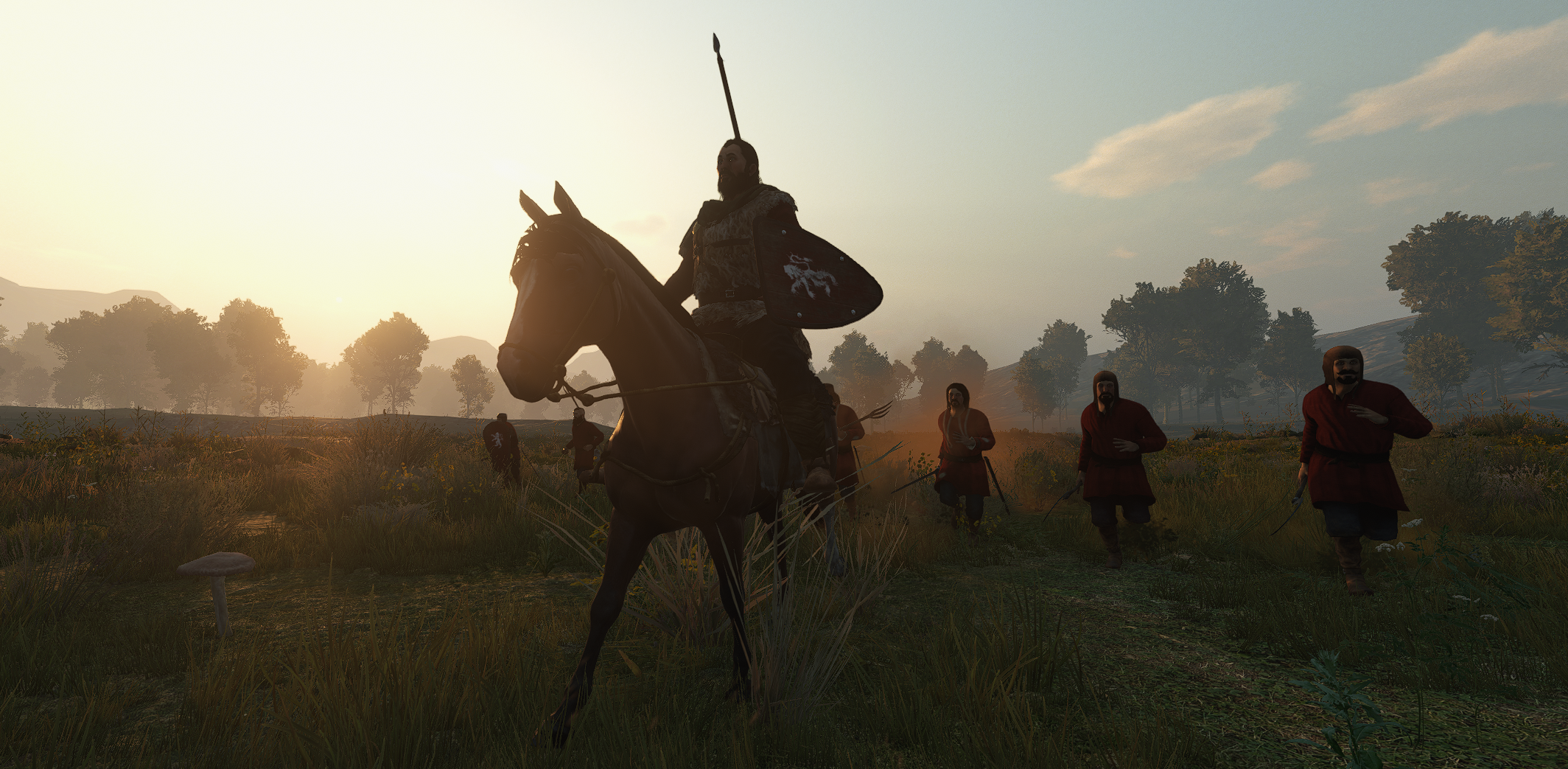
This is the first part of an ongoing review of Mount & Blade II: Bannerlord. It will be expanded on as I progress through the game.
Mount & Blade II: Bannerlord is a sandbox RPG by Turkish developer TaleWorlds, which I have heard aptly described as a “Game of Thrones simulator”. The game is set in a fictional world that mirrors medieval history as it developed directly after the fall of the Roman Empire during the migration period. You play as a minor noble, driven from their ancestral home and trying to establish their own family’s influence by winning battles and eventually gaining enough influence to own land and castles. Beyond the tutorial and one or two optional mission chains, there is no set goal for the game. You are left to your own devices and are free to decide to trade, fight battles or advance your status via political intrigue and marriages.
Similarly to the Total War games, Bannerlord is played mostly in a simplified overworld map that changes to a tactical third person battle view once you engage an enemy on the overworld map. Unlike in the Total War games though, you control your own character directly in the tactical view, and you can also switch to a first person view. You can visit locations like towns and castles in person, without having to engage in battle as well. Aside from armies meeting in open fields and forests, Bannerlord also includes castle sieges – both when attacking enemy fortifications and when defending your own holdings.
In the world of Bannerlord, the Calradic Empire has broken up into three splinter factions: The Northern, Southern and Western Calradic Empire. The Empire is besieged by the hordes of the Khuzait Khanate, encroaching from the steppes of the east and the Sultanate of Aserai advancing out of the southern deserts. At the same time, the Battanians – the indiginous inhabitants of the lands the Empire had conquered at its height – are not completely beaten and still rule a pocket of territory situated in the largely forested heartland of the continent. Also vying for supremacy with these factions are the northern warriors of Sturgia and the western coastal nation of Vlandia.
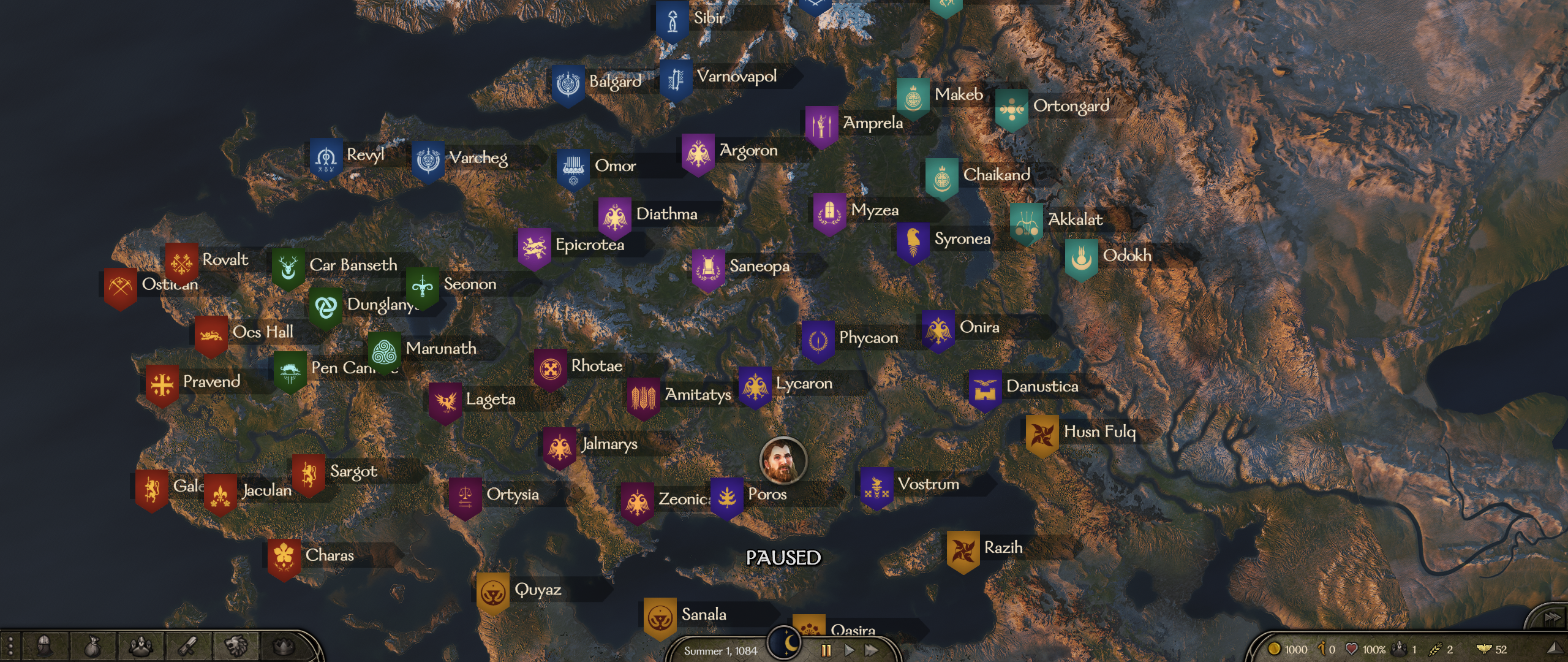
The overworld map in Bannerlord zoomed out: The Northern, Southern and Western parts of the Calradic Empire are represented in purple shades, the Battanians are dark green, the Principality of Sturgia is represented by blue icons, Sturgia by red icons, Aserai is shown in yellow and the hordes of the Khuzait Khanate in the east are shown in light green.
In Bannerlord, the player starts as a wandering noble with only a bit of money, a horse and some weapons and clothes to their name. How you go about playing the game and what you set as your own personal win condition is completely up to you. The tutorial tells you to build up your clan to twenty warriors and earn a certain amount of influence and money. This generally means that you will start the game as a sort of wandering knight mercenary, gaining renown by beating roaming bandit hordes in battle, completing missions for townsfolk or other nobles and by winning tournaments in the major cities of the land.
Once you are famous enough, you can also join one of the existing factions and have your warband fight as part of their armies in one of the minor or major wars which are going on almost all of the time. If you fight well and your army actually makes a difference for your side, you may be awarded your own castle – including the towns and holdings belonging to its territory – once your faction conquers a castle or two. Joining a faction is optional, though. You can also play the Raubritter way by staying independent and simply conquering your own castle all by yourself – you need to have enough money in the bank to pay off the faction you’re going to war with by stealing one of their castles, however.
By joining a faction, or by building up your own political power base from scratch, you will enter into the grand game of politics being played by nobles all over the map. You eventually will want to marry and have children, both to extend your influence through marrying a member of another noble house, and to ensure your legacy by producing heirs. The game ends once your character dies, but if you have children, you can continue to build your legacy by playing on as your own heir – similarly to how it works in Crusader Kings. Since Bannerlord has no set win conditions, you can play on as long as you want, given that your noble line doesn’t die out at one point. In theory, you can keep doing this until you have conquered all of Calradia – an ambitious goal that many players consider to be the ultimate achievement in the game.
The game begins in the year 1084, which, interestingly, was when the Norman sack of Rome happened in our own history. Playing the tutorial, the background story of your character is established as follows: You, your parents and your three siblings were forced to flee your home as a result of the ongoing wars that erupted once the Empire fell apart. In an ambush by brigands, your parents are killed and your younger siblings captured. You and your brother escaped and are now looking to track down the slavers who took your younger brother and sister. While your brother goes off looking for information on where your siblings have been taken, you are left to make money and earn enough renown to be able to exert some influence on the local nobility to eventually mount a rescue mission.
The Adventures of Erilaz of Stargard
My character is a young Battanian warrior named Erilaz, his brother is named Niasen. Erilaz decides to revive the traditions of his parents’ ancestral seat of Stargard, which was lost and forgotten in the civil strife in the Empire, and chooses it as the name for his own re-created noble house. The ancestral coat of arms of the House of Stargard is an upstanding white lion griffon on a red field.
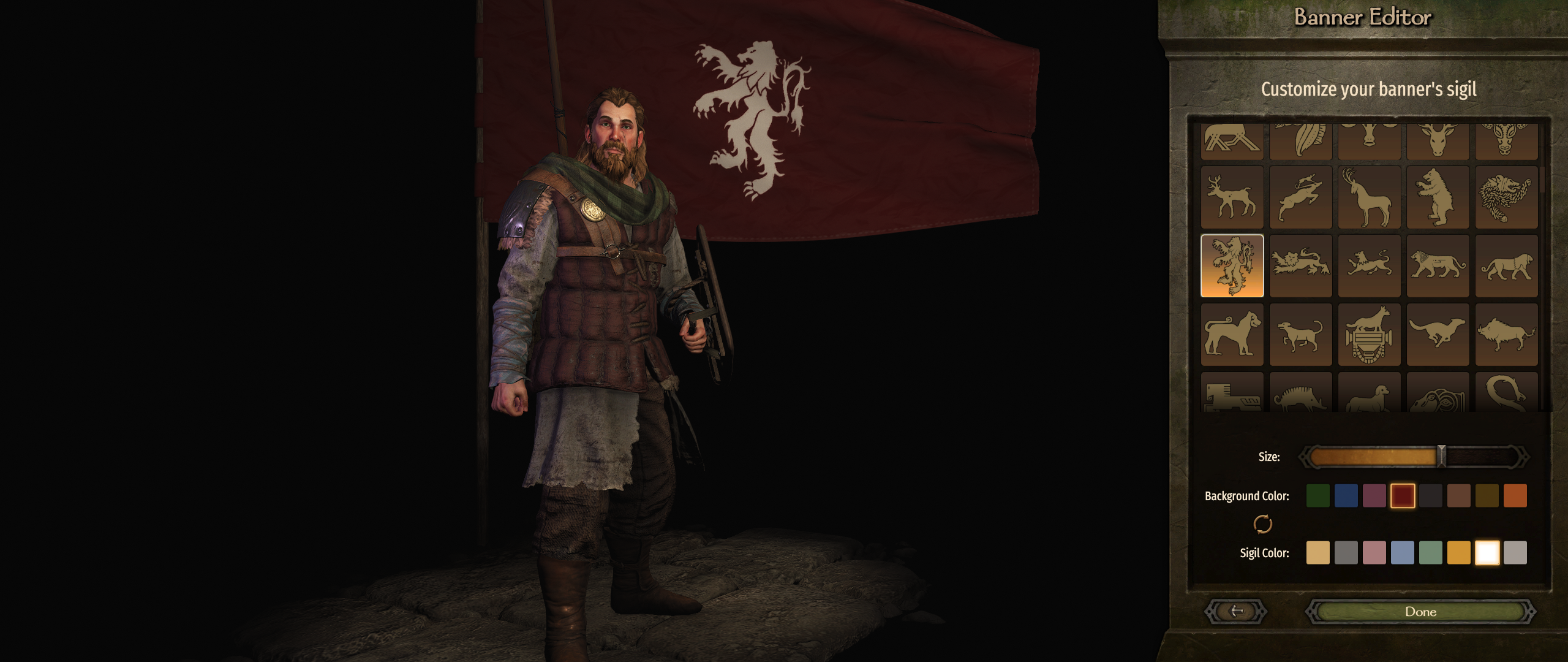
My character Erilaz of the House of Stargard, a Battanian warrior whose parents served in the hearthguard of a minor noble.
After tracking down and defeating the bandits who ambushed them and killed their parents at an inn, Erilaz and Niasen learn that their younger siblings have been sold into slavery. They strike a deal with the leader of the bandits and spare his life in order for him to lead them to the slavers. While Niasen and the brigand gather intelligence on the whereabouts of the slavers, Erilaz hires some warriors, unites them under the banner of his newly created clan and goes about making a name for himself by chasing down the bands of bandits and brigands that roam the countryside of the Western Empire. He also lends a hand to local townsfolk wherever he can, protecting their towns and farms from bandit raiders and trading commodities with them.

Every noble house starts with a few peasants in a field.
While making a name for himself in the countryside of the Western Empire, Erilaz is also investigating an artefact he and Niasen plundered when they routed the bandits that had killed their parents. One of the slaves they rescued was a healer and a scholar who told them that he was on some sort of a “quest”. He had recently come into the possession of a trinket that he had been told was some kind of legendary relic. When he was captured by the bandits, he lost all of his taste for adventure and ceded the chest with the artefact to Erilaz and his brother, forgoing a life of adventure to settle down somewhere in peace and quiet. The only thing he can tell the brothers about the relic is that it has something to do with “Neretzes’ Folly”.
Niasen decides the two brothers should investigate the artefact, so Erilaz surreptitiously questions every lord he comes across on the roads about “Neretzes’ Folly” and in due course learns that it is an alternative name for the Battle of Pendraic. This battle was a major military engagement in 1077, where the Empire, together with Aserai and Khuzait mercenaries, fought Sturgia, which was supported by the Vlandians and Battanians. In this battle, Emperor Neretzes died, which greatly accelerated the decline of imperial authority. On learning that the relic in his possession has something to do with this battle, Erilaz decides to seek out lords that were present at the battle seven years earlier in order to learn more about it.
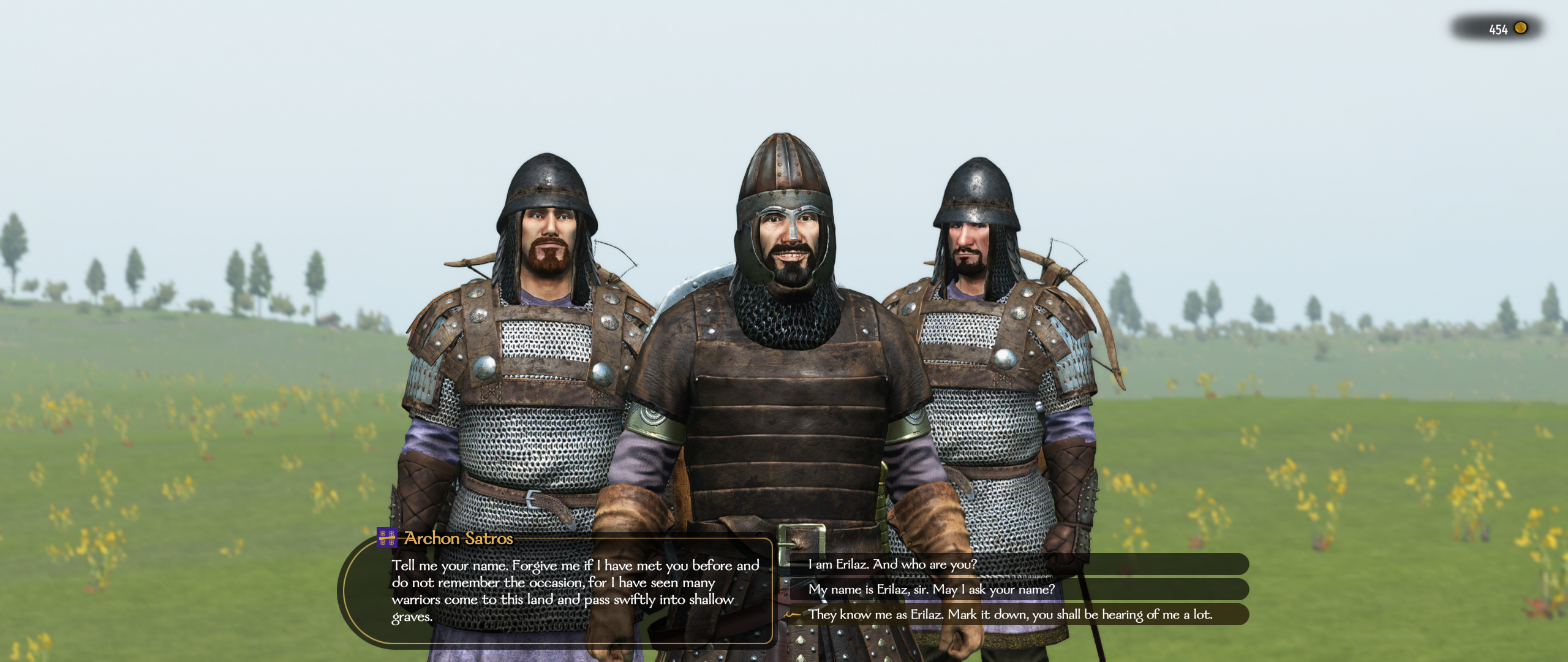
Trying to find out more about Neretzes' Folly, Erilaz talks to every lord he comes across on the roads.
This is where we leave my character in my first Bannerlord campaign. I have thus completed the game’s tutorial and have gathered enough money and men to re-join my brother in a rescue attempt to free our little brother and sister from the clutches of the slavers. All I need now to be able to do this, is to gather some more influence. Therefore, I am fighting bandits on the map, completing missions for honest townsfolk and fighting in arena tournaments to amass enough renown to progress this questline.
First Impressions of the Game
As I’ve never played any of the previous Mount & Blade games, I am learning all of the mechanics of Bannerlord from scratch. That is not an easy task, made harder by a very sparse tutorial. I think that I was only able to learn how the game is played because I’ve been watching someone who knows what they are doing stream the game regularly on Twitch. I wouldn’t say that the game is confusing, most of its mechanics are actually really straightforward, but it does have a lot of moving parts and a lot of the things that are shown in the interface aren’t explained very well (if at all). It is even harder to figure out which mechanics influence other parts of the game behind the scenes. I have a distinct feeling that all of this was built with someone in mind who’s played previous Mount & Blade games. Starting out from scratch with this game is definitely a challenge.
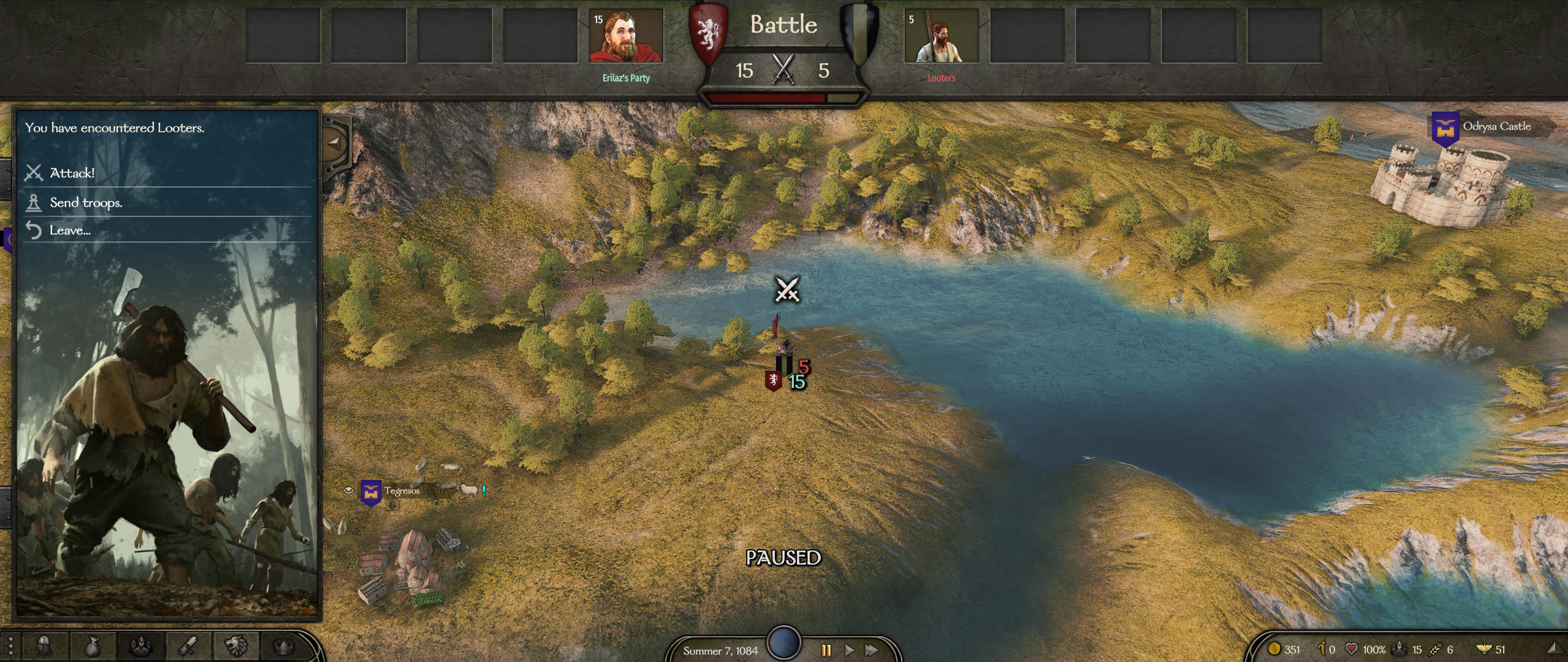
Our warband is chasing down and fighting looters on the overworld map.
That being said, I can already tell that wrapping your head around this game is well worth it. The battles that play out between soldiers in shield walls, archers and mounted warriors are unlike anything I’ve ever seen in a video game. Two hundred mounted knights charging a shield wall of three hundred barbarian warriors truly is a sight to behold! Not to mention the castle sieges… there are soldiers pushing siege towers, ballistas ripping through groups of infantrymen, murder holes decimating invading armies and whole chunks of castle walls being blown apart… Granted, sometimes, individual soldiers act a bit jankily and on occasion a huge battle stalls because the last enemy soldier got stuck in some corner and can’t be reached by the attackers, but as a whole it is very impressive how well the AI in this game portraits these battles. This game is by far the most realistic depiction of medieval combat I’ve seen anywhere. It’s almost uncomfortable how brutal and honest this kind of warfare is.
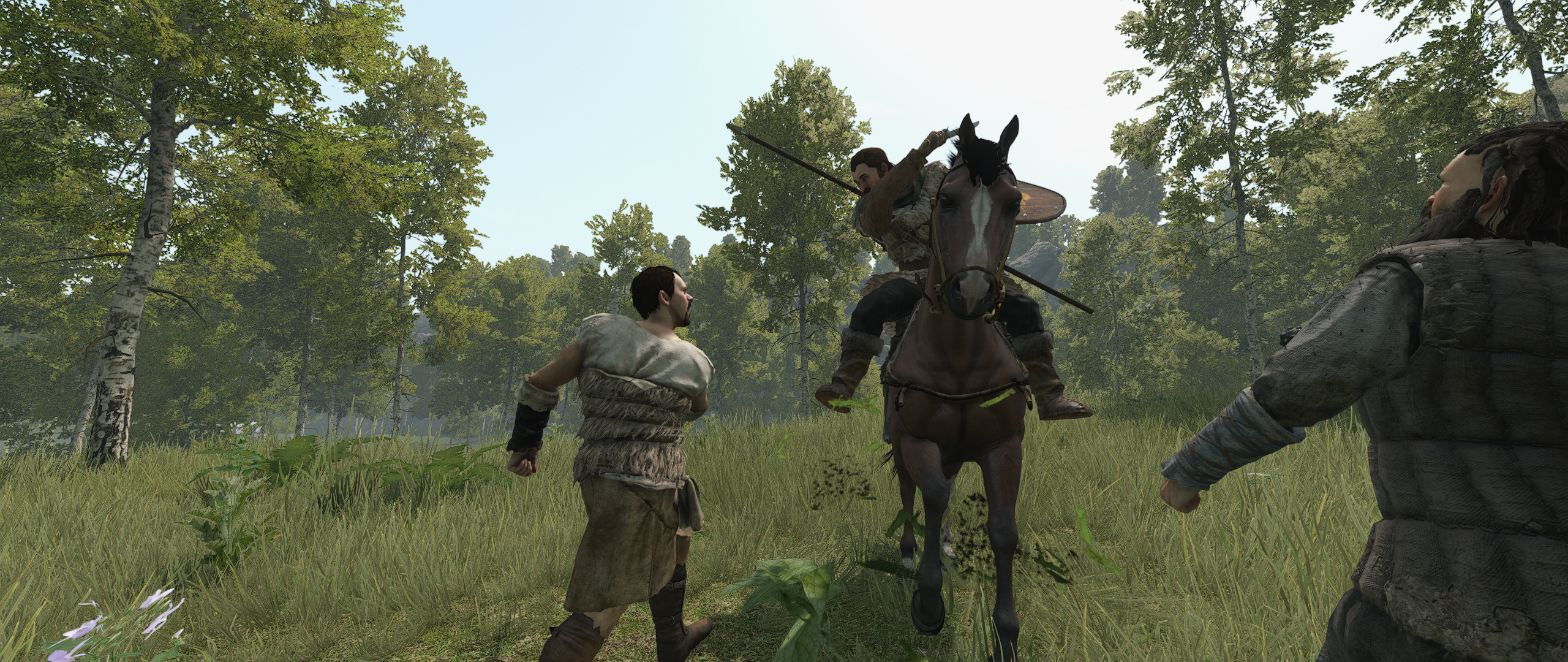
Erilaz is taking to the field to chop down some peasants himself.
After having played a bit more than eight hours, I am still very much in the process of learning my way around this game, so it is much too early to talk about how good of a game it actually is. But what I can say is that I’ve very much enjoyed my time with it so far. Bannerlord is definitely a game you’ll have to have some patience with. Especially if you’ve never played any other games in this franchise before. But if you let yourself be taken along for the ride, a very rich sandbox experience awaits you. And the game seems to be an excellent story generator, which is something I appreciate very much myself.
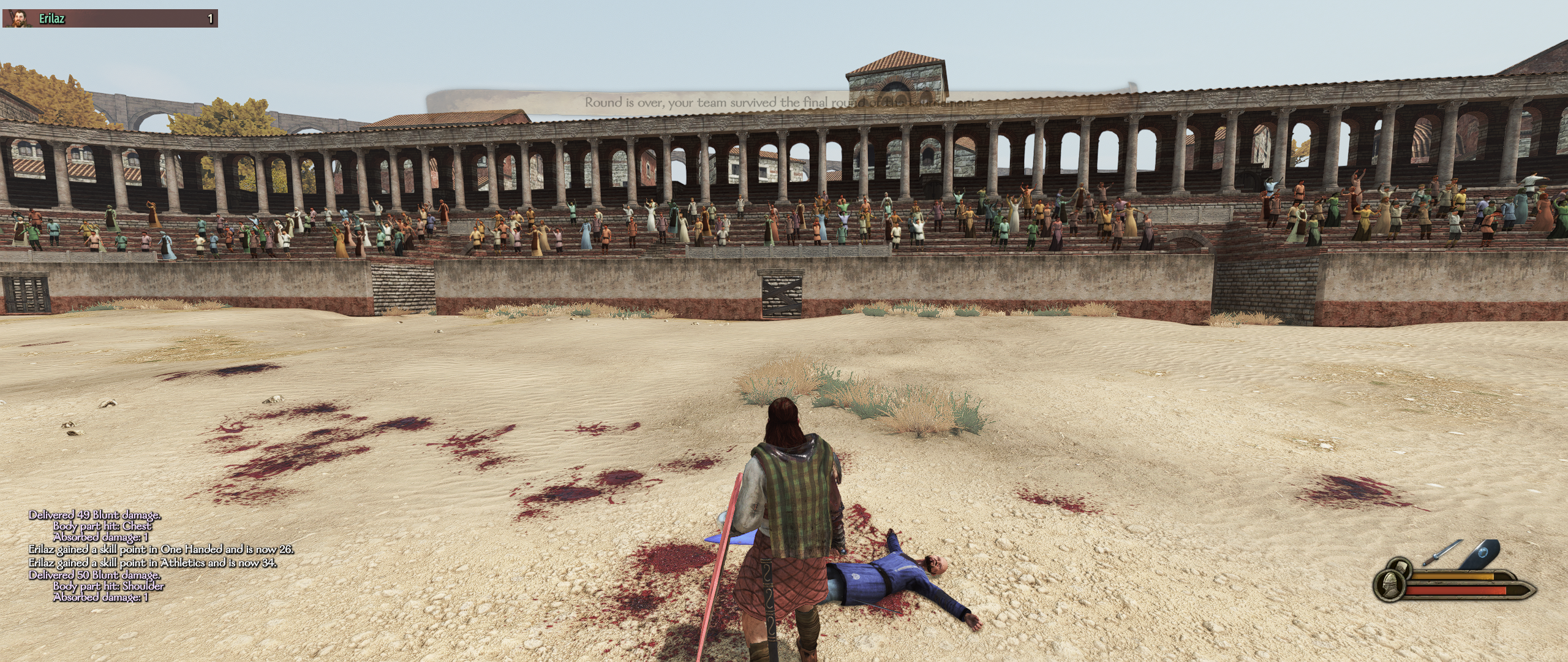
Fighting in the arena to make a name for ourselves.
I’ll definitely keep playing and I’m planning to publish further parts of this review as I am doing so, expanding on the story of Erilaz of Stargard along the way. At this point, I don’t know how long it will take me to reach a final verdict on the game, I don’t know it well enough yet. I guess time will tell.
